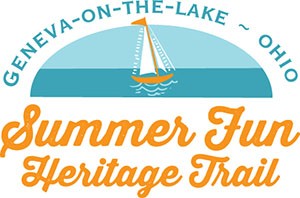In the mid-1920s the need for a dedicated fire department was pressing upon business owners, who were faced with excessively high premiums for fire insurance.
The department, and firetruck, was five miles away in the village of Geneva. That distance, coupled with the abundance of tightly packed wood frame structures in the commercial district, made for rates that ranged from $1.93 to $3.87 per $100 insured. The rates had been raised by the Cox administration during World War I; business owners had been paying 33 cents to $1.10 before the increase.
The state insurance rate bureau required a minimum of 1,000 feet of 2 1/2-inch hose on two “substantial reels to be located in a properly designed house free from serious exposure,” stated a letter from the bureau to the township in 1925. “A volunteer fire department should be organized under the direction of a chief, to consist of 8 to 15 members, permanent residents of the community. The chief should be a responsible party to be held accountable for the proper maintenance of equipment. … the most desirable arrangement would be to provide a suitable motor driven truck for carrying the hose and it should also be provided with large chemical tanks, several smaller extinguishers and also ladders. However, we will agree to accept the hose reels as our minimum requirement.”
In May 1925 a dozen businessmen, led by hotel owner Sidney Ramsey, held a meeting at the Rose Cottage to discuss the property owners’ disadvantage in regard to fire protection and premium rates. The resort community was still part of Geneva Township, which did not have funds for the purchase. The delegation offered to endorse notes to purchase the equipment, the legality of which was called into question. Also questioned was the delegation’s insistence that other funds be raided for the fire protection account.
Trustees did not have the legal authority to secure bonds for a purchase without the consent of voters. And the earliest the issue could be placed before them was the November 1925 general election, too late for the 1925 resort season. Further, since the entire township would have to pay for the truck, those in the south side of the district was against keeping the truck at the resort, or voting for the issue at all. Lake residents and businessmen pointed out that the resort paid most of the taxes collected in the township.
More than firefighting equipment was at stake in this discussion, however. The resort town was moving toward incorporation as a village, and the township was not in favor of the exodus.
The delegation was determined to get the equipment in place by July 4, warning that if a fire were to start in the resort town’s commercial district, the entire tinderbox would be gone within two hours.
In early June the delegation cut a deal — property owners ordered the equipment and guaranteed payment, with the stipulation that if the township failed to take over the obligation, the resort would withdraw from the township and incorporate as a village, which would be responsible for the note.
Ramsey suggested that two fire trucks be purchased, one that would go in the township’s town hall, a second for the village. Only one was ordered — a 1924 Dodge chassis on which the Graham body would be mounted, a “special job” for the factory. Shortly after placing the order, the delegation learned that the fire truck would not be done until near the of the 1925 season, rendering all the discussion a rather moot point.
Nevertheless the property owners petitioned the state to create a fire district. Petitioners were Emory Tyler, Clarence Hoskins, Arthur Bowers, Durwood Bowers, Charles Warner, Sidney Ramsey, Clarence Hoskins, Charles Craine and E.M. Pop Pera.
The “fire hall” for this new truck was to be Emory Tyler’s barn on the north side of Lake Road. Tyler said he didn’t use the barn except for some storage on the first level, and he’d be willing to clean it out so the resort would have a place to park the new truck. His offered was accepted and in return the other men at the table gave him the unpaid job of fire chief. No one, including Emory, had any firefighting experience, however.
The barn was used by the department until 1935, when the Works Progress Administration built both a fire hall and town hall for the village, on South Spencer. The old barn is the tasting and dining room of Old Firehouse Winery. The department moved from South Spencer to a new facility at South Warner in 1971.
Profits from bingo games at several parlors on The Strip funded the department for several decades, until unreasonable restrictions imposed by the state made it impossible to keep the parlors open.
Village Council assumed jurisdiction of the department in 1927, after incorporation. The department was incorporated as a non-profit charitable organization on Feb. 7,1949.
The department got into the rescue and ambulance service in 1939. Its first “ambulance” was a 1941 Plymouth station wagon; a proper ambulance was purchased in 1951.
Fire chiefs:
Emory Tyler: 1925-1930
James R. Boles: 1930-1943
Frank Branford: 1943-1960
Harry Holden: 1960-1970
Larry Brunner: 1970-1972
Tim Boyce: 1972-1974
Edward C. Andrus: 1974-1989
Larry Brunner: 1989
Jim Bartlett: 1989-2008
Tim Mills: 2008-
